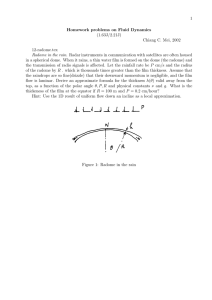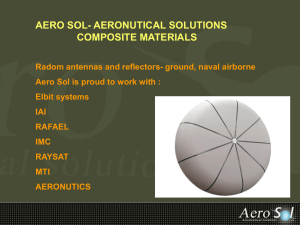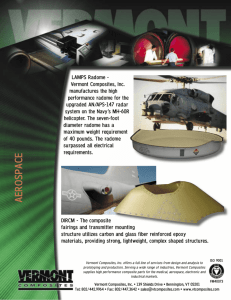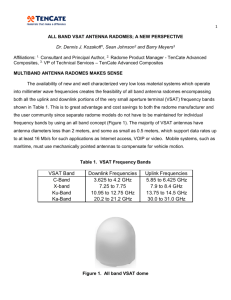METHOD RADOME COMPENSATION a
advertisement
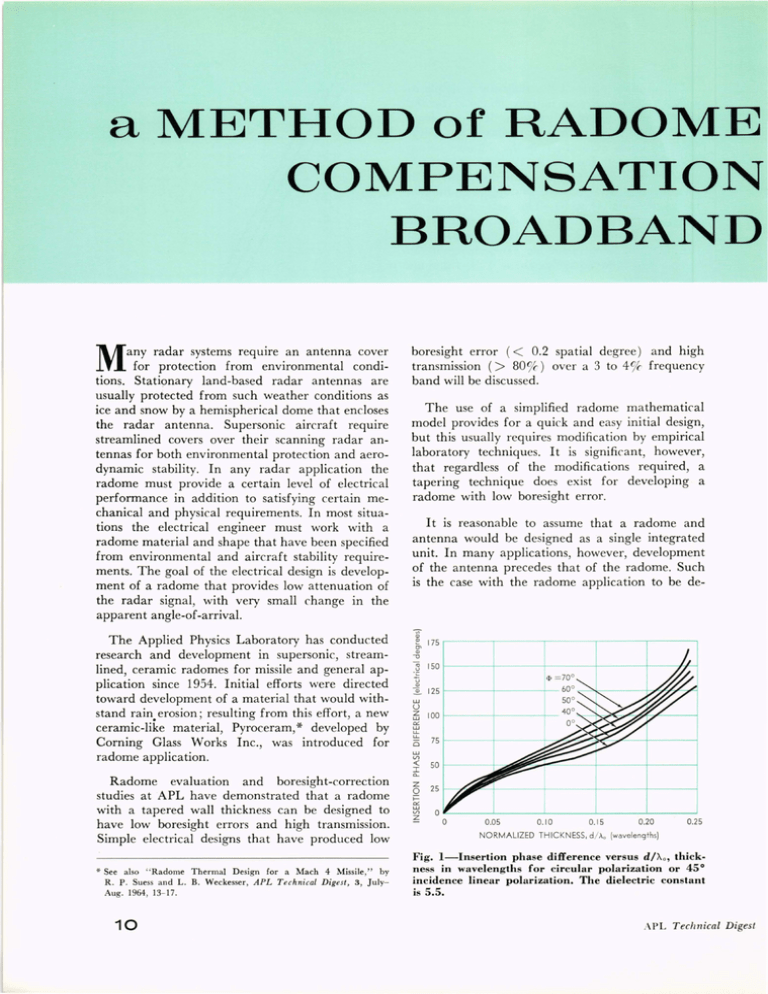
a METHOD of RADOME
COMPENSATION
BROADBAND
M
any radar systems require an antenna cover
for protection from environmental conditions. Stationary land-based radar antennas are
usually protected from such weather conditions as
ice and snow by a hemispherical dome that encloses
the radar antenna. Supersonic aircraft require
streamlined covers over their scanning radar antennas for both environmental protection and aerodynamic stability. In any radar application the
radome must provide a certain level of electrical
performance in addition to satisfying certain mechanical and physical requirements. In most situations the electrical engineer must work with a
radome material and shape that have been specified
from environmental and aircraft stability requirements. The goal of the electrical design is development of a radome that provides low attenuation of
the radar signal, with very small change in the
apparent angle-of-arrival.
The Applied Physics Laboratory has conducted
research and development in supersonic, streamlined, ceramic radomes for missile and general application since 1954. Initial efforts were directed
toward development of a material that would withstand rain. erosion; resulting from this effort, a new
ceramic-like material, Pyroceram, * developed by
Corning Glass Works Inc., was introduced for
radome application.
Radome evaluation and boresight-correction
stud ies at APL have demonstrated that a radome
with a tapered wall thickness can be designed to
have low boresight errors and high transmission.
Simple electrical designs that have produced low
* See
also " Radome Thermal Design for a Mach 4 Missile," by
R . P. Suess a nd L. B. Weckesser, APL T echnical Digest, 3 , JulyAug. 1964, 13- 17.
10
boresight error «
0.2 spatial degree ) and high
transmission (> 80 o/c) over a 3 to 4 o/c frequency
band will be discussed.
The use of a simplified radome mathematical
model provides for a quick and easy initial design,
but this usually requires modification by empirical
laboratory techniques. It is significant, however,
that regardless of the modifications required, a
tapering technique does exist for developing a
radome with low boresight error.
I t is reasonable to assume that a radome and
antenna would be designed as a single integrated
unit. In many applications, however, development
of the antenna precedes that of the radome. Such
is the case with the radome application to be de-
Q)
Q)
g-
175
-0
'"
u
150
u
Q)
~
U
iii
~
0
125
100
75
w
V)
«
it
z
Q
50
25
t-
~
~
0.05
0.10
0. 15
0.20
0.25
NORMALIZED THICKNESS, d/ Ao (wavelengths)
Fig. I-Insertion phase difference versus d/A o, thickness in wavelengths for circular polarization or 45 °
incidence linear polarization. The dielectr.ic con stant
is 5.5.
:\PL T echn ical Digest
Boresight-error measurements on tapered solid-wall radomes have provided
an experimental boresight bandwidth of 3.6%. Boresight bandwidth
is defined as the frequency band over which boresight-error slopes
are less than 0.01 degree/degree in any 20° gimbal rotation.
Theoretical bandwidths extrapolated from experimental
data indicate that bandwidths as high as 5% are
obtainable with ceramic radomes having
a relative dielectric constant of 5.5.
with
CAPABILITY
scribed. Two different antennas of a phase interferometer system were used for boresight measurements of corrected radomes. One is a circularly
polarized, four-quadrant (two interferometers located in orthogonal gimbal planes ) end-fire array.
The other is a four-quadrant, linearly polarized,
slotted waveguide array with the polarization vector at 45° to the gimbal planes. Both interferometer
antennas have similar electrical phase center separations. The initial radome design and corrections
were associated with the circularly polarized antenna because of its improved electrical symmetry.
The goal of this effort was development of a
radome for either or both antennas with boresight
and crosstalk error slopes less than 0.01 degree/ degree over a 20 ° gimbal rotation and transmission
losses less than 1 db over a 9 % bandwidth using a
ceramic radome that has a relative dielectric constant (fr ) of 5.5.
The objective of the tapered-wall investigations
was to devise a taper that would reduce the angular error to zero at a single design frequency. The
resulting boresight bandwidth (i.e. , frequency band
where the angular error slope is less than 0.01
spatial degree/ degree within any 20 ° gimbal rotation) could then be determined experimentally.
Only a 3 to 4 % bandwidth was experimentally
demonstrated. However, the achievement of even
a 3 to 4 % bandwidth is a significant improvement
over previous measured radomes and thus establishes an improved standard for future radome
broadbanding studies.
The experimental method used to construct a
radome taper is to start with a thin radome and
coat it to the appropriate thickness with a machinable compound whose electrical properties
Septell1b er - Octoh e r 196-1
R. H. HallendorfI
match those of the radome material. After a basic
thickness has been built up, the radome taper can
then be turned continuously or in steps on a
contour-follower lathe.
Theoretical Discussion
Two basic design approaches are presented for
discussion. Both are developed to show that simple,
graphical and mathematical procedures are available for quick and easy application to radome design. The first was used for actual construction of
initial radome tapers. The second is presented to
show that improved and simple prediction methods
are available for deriving boresight-correcting
tapers. In both cases antenna parameters such as
aperture area, beamwidth, and near-field distortions are neglected. A complete radome analysis
that includes antenna characteristics as well as
Q)
Q)
cr,
Q)
~
70
-swU
a:i
0
U
60
~
0
w
-'
LD
50
z
«
40
0
4
6
8
10
12
14
16
18
20
22
DISTANC E A LONG RADOME PE RIM ETER
MEAS UR ED FROM TIP, L (inches)
Fig. 2-Incident angle versus distance along the
radome perimeter.
11
.:§
0.236 .--.........- - , - - . - -.........- - , - -.---.---.---.---.---.-----,
g'
i
<1>, =
~,d(
V" -
sin'</> - cos</»
0.23 2
R 212
~0.228
+ arc tan
-<
1-
sin 2a
cos 2a
R '!.]2
'-
~
0.224
Z 0.220
where a is
~
2:,d
(V '<-
sin'</> ), </> is the angle of
U
I O.2 16
f-
~
:(
0.2 12
:2 0.208
<:><:
~ 0.204
L....----l..._....I.-_'-----l..._....I.-_.1...-----1.._-'-_.1...-----1.._-'-----"
o
4
8
10
12
14
16
18
20
22
24
OISTA CE ALONG RAOOME PERIMETER
MEASURED FROM TIP, L (i nches)
Fig. 3-Comparison of theoretical and experimental
tapers, d/A o versus L.
radome effects is a three-dimensional problem that
requires the use of a computer. The experimental
accuracy of the following approaches may suggest
improved computer methods for radome analysis.
The first basic concept used in deriving a radome
taper is to alter the radome-wall thickness in such
a way that the insertion phase at one gimbal angle,
defined as the critical gimbal angle ()o, remains
constant along the radome contour. Measurements
on constant-wall radomes have shown that a boresight-error maximum occurs consistently around
certain gimbal angles, typically 10 to 20 °, depending on radome aspect ratios, etc. The approach of
initial tapering was to reduce the error at the critical gimbal angle without disturbing the error in the
crosstalk plane or at other gimbal angles. Since
crosstalk errors are related to radome-antenna symmetry, an axially symmetrical longitudinal taper
should not affect the crosstalk error.
Plane-wave energy incident at the critical gimbal
angle must retain its plane-wave phase characteristic upon passing through the radome wall. (It is
assumed that refraction and reflection occur only
in the boresight plane of the system; this assumption reduces the complex three-dimensional problem to a simple two-dimensional one. Absorption
loss is also neglected. ) The variation of insertionphase difference <I>ot for circular or 45° linear
polarization as a function of dielectric thickness is
determined from eq ual superposition of perpendicular and parallel polarizations. A typical insertionphase difference for flat-plate dielectrics for linear
polarizations is given by
t
Insertion phase difference (I.P.D .) is defined as the difference
between the phase in the dielectric medium and in air.
12
incidence, f r is the relative dielectric constant, R12
is the reflection coefficient from air to the dielectric
medium, Ao is the free-space design wavelength,
and d is the thickness of the plate. (Two-dimenional flat-plate theory is assumed adequate for
application to curved radome surfaces.)
A plot of insertion-phase differences derived for
circular or 45 ° linear polarization is shown in Fig 1.
As the incident angle 1> is varied, a corresponding
variation in d/ Ao is required to maintain constant
phase difference. The variation of incident angle
along the radome perimeter L is shown in Fig. 2
for various gimbal angles. The data from Figs. 1
and 2 are used to determine the required taper,
i.e., the variation of d/ Ao as a function of L along
the radome perimeter. Theoretically, correction is
needed only along that portion of the radome contour illuminated by the receiver antenna; however,
since the total radome curvature is illuminated by
incoming R-F , a correction taper is made over the
total length to assure compensation. A typical taper
derived for <I> = 135 ° and () = 15 ° is shown in
Fig. 3. Note that no mention has been made of
transmission requirements. The final design is completed by experimentally varying the taper about
the design value.
A second analysis that predicts similar corrections
is more descriptive of the actual physical system
and determines thickness variations for both boresight and transmission requirements. It incorporates
the simple graphical and mathematical procedures
Fig. 4-Monopulse system with phase interferometer
and radome.
.\PL Technical Digest
of optical ray tracing. Figure 4 shows a typical
configuration of phase interferometer and radome.
(I t is assumed that each antenna responds only to
energy propagated along a single optical path. )
Antenna A l is designated as the leading positive
aperture and A 2 as the lagging negative aperture
for a given gimbal direction. A physical separation
a defines the interferometer gain of the antenna
pair. Graphical methods were used to determine the
angle of incidence as a function of station position
along the perimeter as the antenna system is rotated. Figure 5 is a plot of the angle of incidence
versus perimeter location L for both A~ and A~.
Note that at each gimbal angle (except 0°) the
antenna apertures look through the radome at different points along the perimeters with different
angles of incidence. This characteristic contributes
to the boresight error.
...
--_ ..... -
10-
2'
GIMBAL ANGLE FOR N
/
...........
... ...
15-
...
20-
tj
\
j:i
\
\
0
U
\
25-
50
\
0
0z
\
LlJ
\
\
30\
45
\
\
35\
\
\
GIMBAL ANGLE FOR A - /
\
40
,
\
40-
\
\
\
\
35
45-
30
~~
o
j:i
~
0.8
LL
LL
0
()
z
Q 0.7
Vl
Vl
~
z
«
~
I-
0.6
~
~
2
0.5
~
________________
~
0.25
0.20
Fig. 6-Power transmission
for various incident angles.
//
-s- 55
«
1--
NORMALIZED THICKN ESS, d/ Ao (wavelengths)
//
~
~
~
ITI2 versus
d/A.Q thickness
/
,,
,,
,,
,,
,
\
Q)
Q)
0.9
-
0. 15
/
60
.------------~_____::7""..,..=:5l'''''"'ifIPIIIi~-_____,
0.4 L -________________
o
70
65
1.0
__
__- L_ _
6
8
10
~~
4
~~
_ _- L_ _L-~_ _~_ _~~
12
14
16
18
20
22
24
DISTANCE ALONG RADOME PERIMETER
MEASURED FROM TIP, L (inches)
Fig. 5--Incident angle variation (¢) along radome
perimeter L for apertures A + and A -.
SetJ/ell/her- O c/oher 196-1
Optimum transmISSIon for large incident-angle
variations is required to preserve the amplitude
distribution across the antenna aperture when no
dome is present. A change in aperture amplitude
distribution will result in a change of antenna performance. The amount of change for a given radome transmission characteristic is, however, not
easily analyzed. Some positions along the ra dome
perimeter must pass waves over wide ranges of
angles of incidence. For example, from Fig. 5 at
L = 2 in., the incident angle ranges from 71 ° to
57°. At L = 12 in. , the variation is from 47 ° to 70 ° .
To determine the best thickness for a range of incident angles, a plot of power transmission coefficient
ITI2 versus di An is plotted in Fig. 6. Note that
when dl Ao = 0.277, 97 % transmission is obtained
for all incident angles between 0 ° and 70 ° . This
thickness is thus optimum for regions along the
radome perimeter where large ranges of incident
angles must be compensated for maximum transmission. Using data from Figs. 5 and 6, thickness
variations are derived for optimum transmission
through the radome for all gimbal angles (see
Fig. 3). The boresight correction taper is then
matched as closely as possible to the taper derived
for optimum transmission.
For boresight-error correction, a change in thickness is required to compensate for the phase difference between signals received at each aperture
13
TABLE I
BORE SIG HT CORRE CTION DATA
r--
R egion of
Correction
( L- to L +)
(inch es )
Gimbal
Angle
(8)
10
15
20
25
30
35
40
45
2.0 to
5.5 to
8.5 to
10.5 to
12.5 to
14.0 to
15.0 to
16.5 to
--
14.0
17.0
19.0
20.0
21.0
21.5
22.5
23.5
Range of
Angle of
Incidence
(degrees )
R equired
Thickn ess
Correc tion
(w avelength )
Rate of
Correction
(w avelength / in.)
57 - 68
56 - 64
54-59
50-54
46 - 51
43 - 47
38-42
34 - 38
0.0080
0.0053
0.0033
0.0025
0.0032
0.0024
0.0022
0.0020
0.000656
0.000460
0.000314
0.000264
0.000376
0.000321
0.000293
0.000286
~
since each aperture receives energy at different
angles of incidence. For boresight-error correction
at () = 10 ° , the thickness tha t A + (4) = 68 ° ) looks
through must be less than that of A- (4) = 57 ° ) in
order to obtain zero phase difference between the
received signals. From Fig. 5 it is shown tha t at
() = 10 ° , the thickness correction must be applied
over a region along the radome perimeter from
L = 2 in. to L = 14 in. The magnitude of the
change is found from Fig. 7 for incident-angle
variation between 4>+ = 68 ° and 4>- = 57° as
~ (d / Ao) = - 0.0315 ( - 0.0235 ) = -0.0080
wavelength. Table I presents the amount of thickness correction required over a region of radome
perimeter for gimbal angles between 10 ° and 45 ° .
-0.035
I
/
-"
l - 0.030
V
~
.1
-< - 0.D2 5
'-0
Z
o
~ -0.020
/
0<:
«
>
Vl
tD
z
0.01 5
:><:
~
I
f-
@ - 0.010
!:::!
/
:{
:2
0 - 0.005
z
/
/
/
Experimental Tests
V
/'
o ..,/
10
o
20
30
40
50
60
70
80
ANGL E OF INCID ENC E, '" (deg rees)
Fig. 7-Normalized thickness variation for a constant
.insertion phase difference versus incident angle averaged over 0.200 ~ cl lA o ~ 0.240.
14
(Gimbal angles of 0° and 5° have been neglected
since each a perture a t these gimbal angles receives
almost identical signal phase. ) Note that many
regions of boresight correction overlap one another.
For example, at () = 10 °, a correction rate of
0.656 X 1O-:{ wavelength/ in. is needed over a
region from L = 2 in. to L = 14 in., while for
() = 1 5 ~ a correction rate of 0.46 X 10- 3 is needed
over a region from L = 5.5 in. to L = 17 in. The
two regions overlap from L = 5.5 in. to L = 14 in.
To determine an overall correction, the rates
~ ( d / Ao) / ~L are averaged over the radome perimeter. This is a relative thickness variation and can
be m atch ed to the thickness variation derived ~or
optimum transmission. Boresight and transmission
tapers are match ed along the high incidence-angle
regions of the radome perimeter since these are the
most critical to correct. The boresight taper was
m atch ed to the amplitude ta per at L = 2 in. A
compa rison is made of this taper design for boresight correction and that d erived from experimental data in Fig. 3. Agreem ent between theoretical
and experimental tapers are within 0.002 wavelength at the critical high incidence-angle regIons
and within 0.008 wavelength overall.
All laboratory ta pers were designed from theory
generated by plane-wave correction at a critical
gimbal angle. V a rious tapers of different basic
thicknesses with similar taper ra tes were constructed and eva luated. The fi rst successful taper
(ta per No. 1) varied between d lllin / Ao = 0.217 and
dmaxl Ao = 0.236. Figure 8 shows that a minimum
boresight error of 0.1 3 spatial degree occurs at
approximately fi fo = 0.97 3, where fois design frequency associated with design wavelength, with a
resultant boresight bandwidth of about 2.8 o/c . Figure 9 shows a plot of typical boresight-error curves
:\PL Technical Digest
10
polarization and receiver antenna polarization. A
number of experiments were conducted to determine the effect of depolarization on a corrected
radome for both a circularly and a linearly polarized system. Elliptically polarized illuminations were
transmitted through the radome with different
magnitudes of ellipticity and different major axis
orientations. Ellipticity was defined as the log ratio
of power along the major axis to that along the
minor axis. It was determined that a 3- to 4-db
0. 7
'" 0
~~
0.6
e<:
0'"" 0.5
~ ~I
o
1- 1.1)
I
I
~ e<:
~
2
x
«
0.4
0.3
&:0.2
0.1
:2
0.4
0.3
0.2
0.1
0
-0.1
-0.2
0.5
0.4
0.3
0.2
0. 1
0
-0. 1
NORM A LIZED FREQU EN CY, fifo
Fig. 8-Maximum boresight error over frequency
band for three different experimental tapered domes.
over a 9 % bandwidth for a tapered radome. A
second taper was constructed by uniformly reducing the thickness of the No.1 taper to optimize
the radome for a higher frequency. Figure 8 shows
that minimum error occurred around 1110 = 1.04.
The boresight bandwidth of taper No.2 is around
3.6 90 . A third taper with a mean thickness between
tapers No.1 and 2 was constructed for optimizing
near 1110 = 1.0045. Minimum boresight was obtained near 1110 = 1.009, but bandwidth was reduced to about 1.8 o/c . No effort was made to reduce
the bandwidth degredation of taper No.3. Boresight-error curves over a 9% frequency band for
both a circularly and a linearly polarized antenna,
using the No. 3 tapered radome, are very similar;
however, the crosstalk errors for the two antennas
are quite different (Fig. 10 ) . It is probable that
this difference is related to antenna symmetry.
Relative transmission losses for circular polarization in both the boresight and crosstalk planes are
shown in Fig. 11 over a 9 % bandwidth, using the
taper No. 3 radome. It is noted that maximum
transmission efficiency occurs around I I I 0 = 1.045,
while minimum boresight error, as shown in Fig. 8,
occurs near I Ito = 1.009. It is reasonab1.e to expect
that high transmission and low boresight features
should coincide at the same frequency. These experimental conditions indicate, therefore, that the
tapers used are not necessarily the optimum available for simultaneous transmission and boresight
correction.
0.5
0.4
0.3
0.2
0.1
0
- 0.1
Q)
0.5
Q)
0.4
~
0.3
-0
'" 0.2
~
...=:::::::;I,..£l
o~ o.~ I---i.....;~.---+.~~~~~~.-:::~~
__
-0. 1 L _ _...:r::::~tx~:""'L-~_J...-_ _---L_~~
0.5 .---~------,----...-l__- - - . -- -----,-------,
w
0.4
0.3
~
0.2
~
s:
V>
~
en
0. 1
0 ~-=~~~--4~~~~---~~=-==~~
-0. 1
-0.2 L -_ _---L--..:...,~---L----'------'------1.------'
0.5 .---- --y-----,-- - -7I-..:-----.---- ---r------,
0.4
0.3
0.2
0.1
o ~~~~--~~__~~~~~==~~
-0.1 L -_ _---L-~.....~~---'------'------L------'
0.6 . - -- --y-----,-------;..-------.--- ----r------,
0.5
0.4
0.3
0.2
0.1
o ~--~~---t------~~~~~~~
- 0. 1
- 0.2
-0.3
- 0.4
- 0.5 L -_ _...L-_
- 10
_
---'-_ _ __'____ _- ' -_
10
20
30
_
___1. _ _- - '
40
50
G IM BA L ANGL E, 00 (degrees)
Illumination Depolarization
Boresight errors of constant-wall radomes have
shown a dependence on depolarization. This is
defined as the difference between illuminating
Se1)telllb er - Octob er 196.J
Fig. 9-Boresight error for No. 1 tapered radome,
I.r = 0.973 / 0, where / x is the frequency at which minimum boresight error occurs. For comparison, the
boresight error of the un tapered radome is shown in
broken line.
15
ellipticity could be tolerated for all m ajor axis
orientations before bandwidth degradation occurred. The linear depolarization study showed similar
bandwidth degradation when the illuminating polarization was changed with respect to the receiving
antenna. Experim ental boresight-error data show
that boresight errors are dep endent upon the incident polarization, and that a given taper is satisfactory only for a limited range of polarization /
however, tapered-wall radom es provide an average
overall depolarization effect that is much less than
in constant-wall-radomes that we have investigated
in the past.
2.0 ,.--- -- - , . - - - - -- , - - - - - , - -- --,--------,
fifo = 0.955
~.
lI)
z
~ - 2.0
~
:2
--..:.~_ _ _- ' -_ _ _- ' -_
_
_
1.0 ,.--- - - , - - - - - , - - - - --,----
-
- , - - - -----,
L--_ _
-'--_
_
---'
lI)
z
~
0
r---------~::~~~'===::~~~~~~..,
w
~ -1.0
d
1.0
0<::
I
I
.----...
--- --- - - -
- 1.0
Experimental results show that a satisfactory low
boresight (0.01 degree/ degree ) system using a
BORESIGH T PLA NE
9 - 1.0
0
Conclusions
- - . CROSSTALK PLAN E
1.0
0
I
~
..
I
fifo = 1.045
~
I
I
I
I
10
20
30
40
50
GIM BA L ANGLE , 8. (d egrees)
Fig. Il--Transmission loss for a tapered No.3 radome.
1
R. E . Webster a nd D . P. Moore, " Elliptical Polariza tions and
Radome Wall Design ," Proc eedings 0/ th e OSU-WODC Radom e
Symposium, I , June 1957, p. 14.
0.9
0.8
0.7
0.6
0.5
0.4
0.3
0.2
0. 1
"
, ..
- 0. 1
0.6
0.5
0.4
0.3
0, 0.2
Q)
0.1
"0
0
'i" -0.1
........
*
~ 0.5
0<::
0
0<::
~
~
;S
~
~
U
0.4
0.3
0.2
0. 1 I-__~~~~~~____~______~____~____~
0
-0. 1 '--___....I..-_ _ _ _---'-_ _ _ _ _.L..-_ _ _- - ' -_ _ _ _- - - ' ' - - _ - - - - '
0.4 , -- - - , -- - -.....- - - - - - , - - - - , - - - - , , - - _
0.3
0.2
0.1
o ~__~~--.r~------------------------~
-0. 1
- 0.2 '--_ _....I..-_ _---'-_ _ _.L..-_ _--'--_ _- - - ' ' - - - _ - - - - '
0.2 1-1---:;7f"':::IF-=~~~F+=::i::::::=:l
0. 1
o ~~~~~~=-------~~~~~~-=~~
- 0.1
CI RC ULAR POLAR IZATION
-10
o
10
20
30
40
50
G IM BAL ANGLE, 8 0 (degrees)
Fig. IO--Crosstalk errors for a circularly and linearly
polarized antenna system with a tapered No.3 radome.
16
streamlined ta pered-wall ceramic radome can be
developed for operation over at least a 3% boresight bandwidth. Extrapolation of experimental
data indicates that theoretical boresight bandwidths
up to 5 to 6% are achievable with tapered-wall
radomes having an € ,. of about 5.5.
Experim ental and predicted radome designs indicate that boresight correction of a phase monopulse
radome is characterized by a longitudinal decreasing wall thickness from tip to base for radome
thicknesses n ear a half wave. Simplification of the
design procedure can provide quick and easy calculations for absolute thicknesses and taper rates
with better than " ball-park" accuracies. However,
experjmental differences between transmission and
boresight features of experimental, tapered-wall
radomes indicate that additions to the design procedure are n eeded for improved radome correction
designs.
Crosstalk error differences between a linearly
polarized and circularly polarized antenna array
are quite large, indicating a n eed for further antenna evaluation. Correction of a radome for all
polarizations remains a difficult problem to solve;
however, tapered-wall radomes do provide an overall average improvement over previous radomes.
The reasonably successful calculations of boresight correction designs from relatively simple concepts have resulted in the development of an improved radome analysis using computer techniques.
Future computer programs can now be tested and
verified by correlating the experimental solutions
uncovered and discussed in this report.
:\PL Technical D igest
